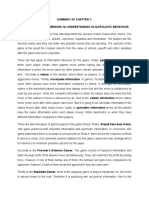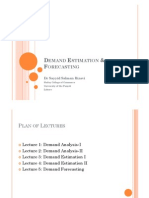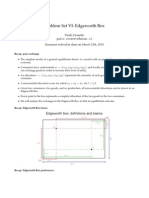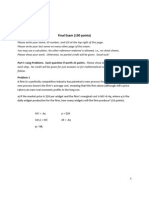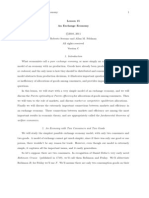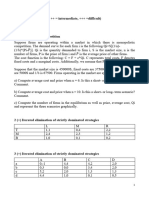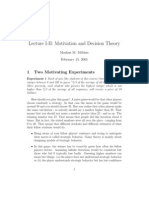Game Theory Exercises 2
Game Theory Exercises 2
Uploaded by
endu wesenCopyright:
Available Formats
Game Theory Exercises 2
Game Theory Exercises 2
Uploaded by
endu wesenOriginal Description:
Copyright
Available Formats
Share this document
Did you find this document useful?
Is this content inappropriate?
Copyright:
Available Formats
Game Theory Exercises 2
Game Theory Exercises 2
Uploaded by
endu wesenCopyright:
Available Formats
Game Theory - Exercises
1. Eliminating Dominated Strategies
Test your knowledge on the following questions.
a) Solve the normal form game in of Fig. 1. by eliminating dominated strategies. Verify that the
resulting solution is a Nash equilibrium of the game.
N C J
N 73,25 57,42 66,32
C 80,26 35,12 32,54
J 28,27 63,31 54,29
Figure 1 Eliminating dominated strategies in a 3 x 3 normal form game.
b) Can a Nash equilibrium to the game in Fig. 2 be found by the iterated elimination of dominated
strategies? If so, describe exactly in what order you delete strategies.
a b c d e
A 63, -1 28, -1 -2, 0 -2, 45 -3, 19
B 32, 1 2, 2 2, 5 33, 0 2, 3
C 54, 1 95, -1 0, 2 4, -1 0, 4
D 1, -33 -3, 43 -1, 39 1, -12 -1, 17
E -22, 0 1, -13 -1, 88 -2, -57 -3, 72
Figure 2 Eliminating dominated strategies in a 5 x 5 normal form game.
2. Second- Price Auction
A single object is to be sold at auction. There are n > 1 bidders, each submitting a single bid,
in secret, to the seller. The value of the object to bidder i is v
i
. The winner of the object is the
highest bidder, but i pays only the next highest bid.
a) Show that truth-telling (i.e., each player i bids v
i
) is a dominant strategy for each player. To
simplify the argument, you can assume, where convenient, that there are no ties.
b) Does your analysis depend on whether or not others tell the truth?
c) What are some reasons that real second-price auctions might not conform to the assumptions
of this model?
3. An Increasing-Bid Auction
A Ming vase is to be sold at auction. There are n bidders, and the value of the vase to bidder
i is v
i
> 0, i = 1, ...., n. The auctioneer begins the bidding at zero, and raises the price at the rate
of $ 1 per second. All bidders who are willing to buy the vase at the stated price put their hands
up simultaneously.This last and highest bidder is the winner of the auction and must buy the vase
for the stated price. Show that this auction has the same optimal strategies and the same outcome
as the Second-Price Auction.
HINT: First show that the only undominated pure strategies for bidder i take the form of
choosing a price p
i
and keeping a hand up until the auctioneers price goes higher than this. Then
nd the optimal p
i
.
1
4. Eliminating Dominated Strategies adAbsurdum
Consider an n-player game in which each player announces simultaneously an integer between
1 and 1000. The winner is the player whose announcement is closed to 1/2 of the average of all
the announcements. In the case of a tie, the price is given by a random draw among the winners.
a) Show that if players iterate the elimination of dominated strategies, the only remaining strategy
is to announce 1.
b) To most people, this does not sound like what would actually happen if n people play this game,
probably because people do, at most, a few iterations of dominated strategies. How many levels
of iteration do you think people actually engage in?
c) Extra credit: Stage the game with some friends, with the payo such that the winner receives
$10.00. Can you estimate how many stage of elimination dominated strategies people will go
through?
5. A Pure Coordination Game
Three people independently choose an integer between two and nine. If the three choices are
the same, each person receives the amount chosen. Otherwise each person loses the amount the
person chose.
a) What are the pure strategy Nash equilibria of this game?
b) How do you think people will actually play this game?
c) What doses the game look like if you allow communication among the players before they make
their choices? How would you model such communication, and how do you think communication
would change the behavior of the players?
6.Variations on Duopoly
In a certain market there are two rms, which we label a and b. If the rms produce output
q
a
and q
b
, then the price they will receive for their goods is given by p = (q
a
+ q
b
) or zero
if p would otherwise be negative. Each rm has marginal cost c > 0 and no xed costs. Suppose
> 3c (youll see why we make this assumption as you go through the problem.)
a) Suppose the rm choose the quantity q
a
and q
b
independently in each period, without regard
to their behavior in previous periods, and each maximizes prots
a
= (p c)q
a
and
b
=
(p c)q
b
.Find the unique pure strategy Nash equilibrium to this game. This is called the
CournotDuopoly model.
b) Suppose the two rms collude by agreeing that each will produce an amount q
= q
a
= q
b
,
and they have some way to enforce the agreement. What should they choose for q
? What
are the prots of the two rms? Compare this with the Cournot duopoly prots. This Nash
equilibrium is called the Monopolymodel or the Cartelmodel.
c) Suppose rm a reneges on its promise on the previous part but b doses not. What should a
choose for q
a
? What are as prots, and what are bs prots?
d) Suppose rm b nds out that rm a is going to do in the previous part, and chooses q
b
to
maximize prots, given what rm a is going to do. What is q
b
now? What do you think
happens if they go back and forth this way forever?
2
e) Suppose the two rms choose price as opposed to quantity, where costumers all go to the lowest-
price rm, and the rm split the market if they choose the same price. What is the unique Nash
equilibrium of this game? This is called the Bertrandduodolymodel. Bertands result is often
called a paradox. In what sense do you think this is an accurate description of this solution?
How do you explain the dramatic dierence in outcomes between this and the Cournot model?
f) Suppose rm a gets to choose its output rst and only afterwards doses rm b get to choose its
output. Find the equilibrium choices of q
a
and q
b
in this case, and compare the prots of the
two rms with the Cournot duopoly case. This is called the Stackelbergduopolymodel. HINT:
Firm a should nd its prot for every q
a
, given that rm b will choose q
b
to maximize its prots
given q
a
. Then, among all these prots, rm a choose q
a
to maximize prots.
7. The Rotten Kid Theorem
This problem is core of Gary Beckers (1981) famous theory of the family. You might check the
original, through, since Im not sure I got the genders right.
1
A certain family consists of a mother and a son, with increasing, concave utility funktions u(y)
for the mother and v(z) for the sun. The sun can aect both his income and of the mother by
choosing a level of familial work commitment a, so y = y(a) and z = z(a). The mother, however,
feels a degree of altruism > 0 towards the son, so given y and z, she transfers an amount t to
the son to maximize the objective function.
u(y t) + v(z + t) (1)
The son, however is perfectly selsh (rotten), and chooses the level of a to maximize his own
utility v(z(a) + t). However he knows that his mothers transfer depends on y and z, and hence
on a.
a) Use backward induction to show, what the son chooses a to maximize total family income
y(a) + z(a).
b) Show that t is an increasing function of . Also if we write y = y(a) + y, and t is an increasing
function of the mothers exogenous wealth y.
c) Show that for suciently small > 0, t < 0; i.e., the transfer is from the son to the mother.
HINT: For each a, the mother observes y(a) and z(a), and chooses t = t(a) to maximize (1).
This gives the rst-order condition u
+v
= 0.Dierentiate the rst-order condition with respect
to a to show that the solution to the rst-order condition for the maximization of z(a) + t(a) is
the same as for the maximization of y(a) + z(a) = 0.
1
The Rotten Kid Theorem has been empirically tested and receives some support, through
the evidence falls short (often way short) of conrming that cross-generational families maximize
joint income. See Cox 1987, 1990; Cox and Rank 1992; and Altonji et al. 1992, 1997.
3
You might also like
- Town of Passion Guide (1.5.3)Document174 pagesTown of Passion Guide (1.5.3)Ari Safutra75% (4)
- Humblewood - StrigDocument5 pagesHumblewood - StrigHéctor Rodríguez AntúnezNo ratings yet
- Game Theory (Part 1)Document81 pagesGame Theory (Part 1)TahaNo ratings yet
- Evereska by PhasaiDocument42 pagesEvereska by Phasaiadam kyser100% (6)
- Summary Game TheoryDocument54 pagesSummary Game TheorytNo ratings yet
- Lecture 4 Day 3 Stochastic Frontier AnalysisDocument45 pagesLecture 4 Day 3 Stochastic Frontier Analysistrpitono100% (1)
- Ec2065 2013Document70 pagesEc2065 2013staticbitezNo ratings yet
- M3S11: Games, Risks and DecisionsDocument78 pagesM3S11: Games, Risks and DecisionsAlex ZhouNo ratings yet
- Baye 9e Chapter 09 PDFDocument33 pagesBaye 9e Chapter 09 PDFnita sugiarta wijayaNo ratings yet
- The Correlation Structure of Security Returns: Multiindex Models and Grouping TechniquesDocument26 pagesThe Correlation Structure of Security Returns: Multiindex Models and Grouping TechniquessaminbdNo ratings yet
- Microeconomics SLN CH 1 - Besanko, 4th Edition PDFDocument21 pagesMicroeconomics SLN CH 1 - Besanko, 4th Edition PDFj100% (1)
- Test - Game TheoryDocument4 pagesTest - Game TheoryAmmi Julian100% (1)
- Spark RPG ColourDocument209 pagesSpark RPG ColourMatthew Jackson75% (4)
- SRS GamingDocument10 pagesSRS GamingPayal Kumari100% (3)
- ProblemBank203 2Document86 pagesProblemBank203 2canerNo ratings yet
- Introduction To Game Theory (Harvard) PDFDocument167 pagesIntroduction To Game Theory (Harvard) PDFAndresMartinez28No ratings yet
- Game Theory Exam QuestionsDocument13 pagesGame Theory Exam QuestionsPaulNo ratings yet
- 3b Extensive-Form GamesDocument17 pages3b Extensive-Form GamesMuhammad Ramzan100% (1)
- Game TheoryDocument181 pagesGame Theoryrajan20202000100% (1)
- Chapter 7: Game TheoryDocument6 pagesChapter 7: Game TheoryPrince DesperadoNo ratings yet
- Compensating Variation, Equivalent Variation, Consumer Surplus, Revealed PreferenceDocument10 pagesCompensating Variation, Equivalent Variation, Consumer Surplus, Revealed Preferencehishamsauk100% (1)
- OA1600-Game TheoryDocument46 pagesOA1600-Game Theoryislam tamimNo ratings yet
- Lecture 2 Game TheoryDocument33 pagesLecture 2 Game TheoryProf. Sanjay Christian100% (1)
- Chapter 10 - SummaryDocument16 pagesChapter 10 - SummaryTonyNo ratings yet
- ProblemSet5 SolutionsDocument11 pagesProblemSet5 SolutionsJatin100% (1)
- Tugas Grup Chapter 12Document32 pagesTugas Grup Chapter 12Haryadi WidodoNo ratings yet
- Midterm ReviewsDocument4 pagesMidterm ReviewsBách NguyễnNo ratings yet
- Demand Estimation & ForecastingDocument15 pagesDemand Estimation & ForecastingSufana UzairNo ratings yet
- Game Theory (2016, Notes)Document27 pagesGame Theory (2016, Notes)Dantè ChiapperiniNo ratings yet
- Financial Econometrics NotesDocument115 pagesFinancial Econometrics Notesboot_sectorzNo ratings yet
- frm指定教材 risk management & derivativesDocument1,192 pagesfrm指定教材 risk management & derivativeszeno490No ratings yet
- Oligopoly NumericalsDocument8 pagesOligopoly NumericalsShivi ChaturvediNo ratings yet
- Econ 414 Lecture: Mixed Strategies: Jeff BorowitzDocument55 pagesEcon 414 Lecture: Mixed Strategies: Jeff Borowitzjclv.youknow8373No ratings yet
- Economics - Markets With Asymmetric InformationDocument21 pagesEconomics - Markets With Asymmetric Informationragneshr100% (1)
- Baye 9e Chapter 10 PDFDocument36 pagesBaye 9e Chapter 10 PDFnita sugiarta wijayaNo ratings yet
- 4.1 Game TheoryDocument73 pages4.1 Game Theoryragul shreeNo ratings yet
- Game Theory Is "The Study ofDocument32 pagesGame Theory Is "The Study ofndmudhosiNo ratings yet
- Chapter 9 - Multifactor Models of Risk & ReturnDocument10 pagesChapter 9 - Multifactor Models of Risk & ReturnImejah FaviNo ratings yet
- RL03-04. Game TheoryDocument8 pagesRL03-04. Game TheoryKeshav KumarNo ratings yet
- Declare Time Variable Using VAR in Stata: How To Perform Granger Causality Test in STATA?Document1 pageDeclare Time Variable Using VAR in Stata: How To Perform Granger Causality Test in STATA?AselNo ratings yet
- Monopolistic Competition and Oligopoly: Key ConceptsDocument16 pagesMonopolistic Competition and Oligopoly: Key ConceptsAnonymous leF4GPYNo ratings yet
- Exercises - Game Theory Questions PDFDocument10 pagesExercises - Game Theory Questions PDFTeyma TouatiNo ratings yet
- Baye 9e Chapter 03Document39 pagesBaye 9e Chapter 03Mae Justine Joy TajoneraNo ratings yet
- Summary Slide: DR - Anup Raj Markt), PGDPM, PH.D in DerivativeDocument82 pagesSummary Slide: DR - Anup Raj Markt), PGDPM, PH.D in DerivativeNaveen KumarNo ratings yet
- Arch Garch AssignmentDocument5 pagesArch Garch AssignmentSurbhiVijhaniNo ratings yet
- Pset6 Solutions HandoutDocument10 pagesPset6 Solutions HandoutthemiykNo ratings yet
- EC204 Topic 3 - Oligopoly and Game Theory Applications Student Slides PDFDocument30 pagesEC204 Topic 3 - Oligopoly and Game Theory Applications Student Slides PDFKareena TekwaniNo ratings yet
- Lec SlidesDocument69 pagesLec SlidesDavissen MoorganNo ratings yet
- EC2066Document49 pagesEC2066Josiah KhorNo ratings yet
- Advanced MacroeconomicsDocument420 pagesAdvanced MacroeconomicsLucas Ordoñez0% (1)
- Arbitrage Pricing Theory - APTDocument60 pagesArbitrage Pricing Theory - APTSwara SrivastavaNo ratings yet
- IS-LM FrameworkDocument54 pagesIS-LM FrameworkLakshmi NairNo ratings yet
- Game TheoryDocument4 pagesGame TheoryAnjali LakraNo ratings yet
- Options CA - CS.CMA - MBA: Naveen. RohatgiDocument38 pagesOptions CA - CS.CMA - MBA: Naveen. RohatgiDivyaNo ratings yet
- 10 - Market EfficiencyDocument5 pages10 - Market EfficiencyJosh AckmanNo ratings yet
- Chapter 7 MonopolyDocument121 pagesChapter 7 MonopolyMatías Plaza GarcíaNo ratings yet
- Final Exam 100A SolutionsDocument16 pagesFinal Exam 100A SolutionsJessie KongNo ratings yet
- WARP&SARP (2) Notes PDFDocument39 pagesWARP&SARP (2) Notes PDFTrinanti AvinaNo ratings yet
- Lesson15PlusGraphs-An Exchange EconomyDocument36 pagesLesson15PlusGraphs-An Exchange Economyamrith vardhanNo ratings yet
- Welfare TheoremsDocument8 pagesWelfare TheoremsJesús M. VilleroNo ratings yet
- Computer Network Assignment Help: ProblemsDocument7 pagesComputer Network Assignment Help: ProblemsComputer Network Assignment Help100% (1)
- Test - Game Theory PDFDocument4 pagesTest - Game Theory PDFAmmi Julian100% (1)
- Problem Set 3Document2 pagesProblem Set 3Hoanglucia0% (1)
- Problem Set 1 - TextDocument4 pagesProblem Set 1 - TextMIGUEL ROMERO FNo ratings yet
- Lecture I-II: Motivation and Decision Theory - Markus M. MÄobiusDocument9 pagesLecture I-II: Motivation and Decision Theory - Markus M. MÄobiuskuchbhirandomNo ratings yet
- 12 - Handout On ESS in Pure Strategies #3Document5 pages12 - Handout On ESS in Pure Strategies #3Edwin Ramiro Torrico VargasNo ratings yet
- Mixed Strategies Handout Yale CourseDocument3 pagesMixed Strategies Handout Yale Courseendu wesenNo ratings yet
- Game Theory Exercise and SolutionDocument1 pageGame Theory Exercise and Solutionendu wesenNo ratings yet
- Mixed Integer Prog - Excel Solver Practice ExampleDocument22 pagesMixed Integer Prog - Excel Solver Practice Exampleendu wesenNo ratings yet
- SQC Final Exam June 2010Document4 pagesSQC Final Exam June 2010endu wesenNo ratings yet
- Polynomial Time ReductionDocument17 pagesPolynomial Time Reductionendu wesenNo ratings yet
- Derivatives PDFDocument470 pagesDerivatives PDFendu wesen100% (2)
- Durablegoods MonopolyDocument6 pagesDurablegoods Monopolyendu wesenNo ratings yet
- SQC TestDocument10 pagesSQC Testendu wesenNo ratings yet
- Decision Making Under Uncertainity PDFDocument12 pagesDecision Making Under Uncertainity PDFendu wesenNo ratings yet
- Topic Four:: Portfolio Optimization: Analytical TechniquesDocument50 pagesTopic Four:: Portfolio Optimization: Analytical Techniquesendu wesenNo ratings yet
- Harvard PortfolioOptimization PDFDocument144 pagesHarvard PortfolioOptimization PDFbboyvnNo ratings yet
- Static Games of Complete Information PDFDocument12 pagesStatic Games of Complete Information PDFendu wesenNo ratings yet
- BEE1020 - Basic Mathematical Economics Juliette Stephenson Amr Algarhi Homework - Solution Department of Economics Week 4 University of ExeterDocument2 pagesBEE1020 - Basic Mathematical Economics Juliette Stephenson Amr Algarhi Homework - Solution Department of Economics Week 4 University of Exeterendu wesenNo ratings yet
- Effecient Frontier Stock PortfoliosDocument60 pagesEffecient Frontier Stock Portfoliosee1993No ratings yet
- There and Back Again: AbilitiesDocument3 pagesThere and Back Again: AbilitiesAntonio EleuteriNo ratings yet
- Xenia Meet InfoDocument1 pageXenia Meet InfoAnonymous BAqpDrNo ratings yet
- Novo (A) Documento Dos LinksDocument47 pagesNovo (A) Documento Dos LinksConta Do FDPNo ratings yet
- The Clumps in The World CupDocument12 pagesThe Clumps in The World Cupapi-253066048No ratings yet
- Spectres of Brocken Digital Singles Release V1.1Document122 pagesSpectres of Brocken Digital Singles Release V1.1Bruno Samuel Cunha De AbreuNo ratings yet
- Libram of Lost Spells Volume 1Document13 pagesLibram of Lost Spells Volume 1paendrag2345100% (4)
- Tybcom Practical It SubjectDocument23 pagesTybcom Practical It Subjectaksh100% (1)
- Hananacraft BE Catalogue v1.2Document30 pagesHananacraft BE Catalogue v1.2coffe MilkNo ratings yet
- BANSBACH Gas Springs Quick Ship Catalogue 2011enDocument10 pagesBANSBACH Gas Springs Quick Ship Catalogue 2011enGustavo BermudezNo ratings yet
- Copy Ndsu PageDocument1 pageCopy Ndsu PageinforumdocsNo ratings yet
- Baital Pachisi in UrduDocument121 pagesBaital Pachisi in UrduMuhammad AsgharNo ratings yet
- RomsDocument106 pagesRomsitalo naelNo ratings yet
- K/Da - Villain: Arr. Murdershards Riot Games Ft. Madison Beer and Kim PetrasDocument3 pagesK/Da - Villain: Arr. Murdershards Riot Games Ft. Madison Beer and Kim PetrasRyan LameiroNo ratings yet
- Pathfinder 2e (PZO90180) Outlaws of Alkenstar #3-3 - Smoking Gun - Interactive MapsDocument8 pagesPathfinder 2e (PZO90180) Outlaws of Alkenstar #3-3 - Smoking Gun - Interactive MapsLivio TupinambaNo ratings yet
- Coding Form TransaksiDocument13 pagesCoding Form TransaksiPeri HidayatNo ratings yet
- Space Opera Seldon S Compendium of Starcraft 2Document50 pagesSpace Opera Seldon S Compendium of Starcraft 2Lecomte100% (3)
- Brave The Labyrinth 01Document32 pagesBrave The Labyrinth 01DizetSma100% (2)
- Bibliography GiobbiDocument20 pagesBibliography GiobbiAnonymous z5EIDvQdNo ratings yet
- HL 93Document4 pagesHL 93thuytrangNo ratings yet
- SFL Week 20 ScheduleDocument5 pagesSFL Week 20 ScheduleEdgar NalundasanNo ratings yet
- Color Names Supported by All BrowsersDocument4 pagesColor Names Supported by All BrowsersBala Ganga DharNo ratings yet
- Anubis ABS-5YDocument1 pageAnubis ABS-5YdjblackhammerNo ratings yet
- High School Heroes GDD v2.0 REVISEDDocument23 pagesHigh School Heroes GDD v2.0 REVISEDPrayforMojo81No ratings yet
- Lords 3Document3 pagesLords 3garvit9811No ratings yet
- Percy Jackson and The SurpriseDocument17 pagesPercy Jackson and The SurpriseTRON JONESNo ratings yet



















